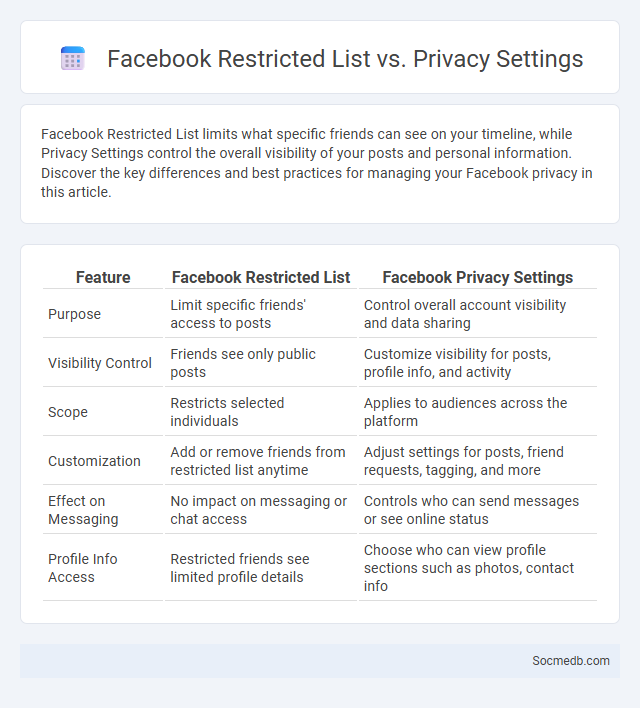
Photo illustration: Facebook Restricted List vs Privacy Settings
Facebook Restricted List limits what specific friends can see on your timeline, while Privacy Settings control the overall visibility of your posts and personal information. Discover the key differences and best practices for managing your Facebook privacy in this article.
Table of Comparison
| Feature | Facebook Restricted List | Facebook Privacy Settings |
|---|---|---|
| Purpose | Limit specific friends' access to posts | Control overall account visibility and data sharing |
| Visibility Control | Friends see only public posts | Customize visibility for posts, profile info, and activity |
| Scope | Restricts selected individuals | Applies to audiences across the platform |
| Customization | Add or remove friends from restricted list anytime | Adjust settings for posts, friend requests, tagging, and more |
| Effect on Messaging | No impact on messaging or chat access | Controls who can send messages or see online status |
| Profile Info Access | Restricted friends see limited profile details | Choose who can view profile sections such as photos, contact info |
Introduction to Facebook Privacy Tools
Facebook offers a variety of privacy tools designed to help users control who can see their posts, personal information, and online activity. Users can customize settings such as profile visibility, friend lists, and location sharing to safeguard their digital footprint. Regularly updating these privacy configurations enhances security and ensures a safer social media experience.
What Is the Facebook Restricted List?
The Facebook Restricted List is a privacy feature that limits what certain friends can see on your profile without unfriending them. When you add someone to this list, they only view posts and information you make public, helping you control your content visibility effectively. Your restricted list ensures selective sharing, enhancing your social media privacy without severing connections.
Understanding Facebook Privacy Settings
Understanding Facebook privacy settings is crucial for protecting your personal information and controlling who can see your posts, photos, and profile details. You can customize settings to manage audience restrictions, limit friend requests, and adjust ad preferences, ensuring your online presence aligns with your comfort level. Regularly reviewing and updating these controls helps maintain your security against unauthorized access and data misuse.
Differences Between Restricted List and Privacy Settings
Restricted List limits specific contacts from seeing your posts without removing them from your friends, allowing you to control individual access discreetly. Privacy Settings offer broader controls to customize who can view your entire profile, posts, or personal information, affecting all users or defined groups at once. Understanding these differences helps you tailor your social media experience to protect Your content effectively and maintain desired boundaries.
How to Add Friends to the Restricted List
To add friends to the Restricted List on Facebook, navigate to the friend's profile, click on the "Friends" button, and select "Edit Friend List," then choose "Restricted." Users on the Restricted List can only see posts and information you make public, enhancing privacy without unfriending. This feature is crucial for selectively controlling content visibility while maintaining connections on social media platforms.
Controlling Visibility with Privacy Settings
Controlling visibility on social media platforms is essential for protecting personal information and managing online presence effectively. Privacy settings allow users to customize who can view posts, access profile details, and interact with shared content, enhancing security and reducing exposure to unwanted contacts. Utilizing features such as audience selectors, friend lists, and activity log controls empowers individuals to maintain a tailored digital footprint aligned with their privacy preferences.
Use Cases: When to Use Each Option
Social media platforms offer diverse use cases tailored to different goals and audiences, such as Instagram for visual storytelling and brand awareness, LinkedIn for professional networking and B2B marketing, and Twitter for real-time engagement and customer service. You should choose each option based on your target demographic, content type, and desired interaction, ensuring the platform aligns with your marketing objectives. Understanding these use cases enhances your ability to connect effectively, increase reach, and drive meaningful engagement with your audience.
Pros and Cons: Restricted List vs Privacy Settings
Social media platforms offer Privacy Settings that allow You to control who can access Your personal information, providing a tailored safeguard for Your digital presence. However, relying solely on Privacy Settings may lead to unintended exposure due to platform updates or complex configurations. A Restricted List, in contrast, offers a more direct approach by limiting specific users' access, balancing ease of use with targeted privacy management.
Common Misconceptions About Privacy Options
Many users mistakenly believe that social media privacy settings fully protect their personal information, but default options often leave significant data exposed. Platforms frequently update privacy policies, creating confusion about what information is visible to others and third parties. Understanding the limitations and regularly reviewing settings is crucial to maintaining genuine control over online privacy.
Best Practices for Managing Facebook Privacy
Managing Facebook privacy effectively involves regularly reviewing and customizing privacy settings to control who can see your posts, personal information, and friend list. Utilize features like Audience Selector to limit visibility and enable two-factor authentication for enhanced account security. Consistently audit third-party app permissions and be cautious about sharing sensitive content to minimize risks of data exposure.
 socmedb.com
socmedb.com